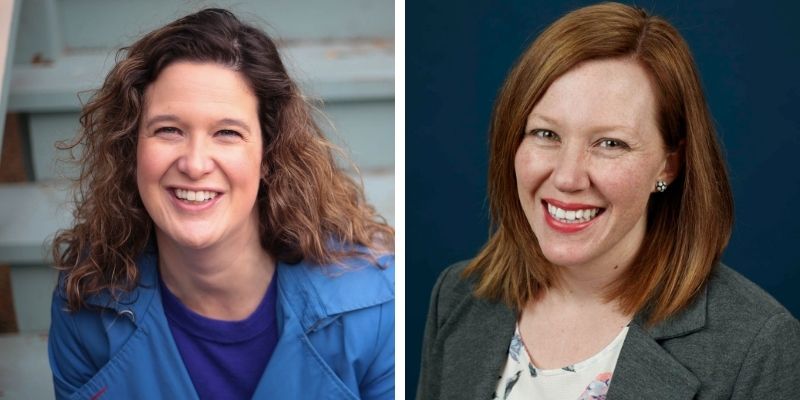ISN gathers 120+ Participants for a Critical Analysis of Alternative Break Trips and Whiteness in Catholic Education
BY AJ ROWE | February 1, 2022
A discussion centered around structures of whiteness present in Catholic education is a daunting task, particularly for those who are white. But on Wednesday, January 19, over 120 participants from across the country representing Jesuit and other universities gathered to discuss this very topic. Hosted by Susan Haarman, M.Div, M. Ed., L.P.C., from Loyola Chicago’s Center for Experiential Learning and Annie Selak, Ph.D., from the Georgetown University Women’s Center, this webinar did not shy away from the idea of discomfort—in fact, it embraced it, with Haarman encouraging participants to “lean into the discomfort” that discussions like this tend to bring about.

Susan Haarman and Dr. Annie Selak
Susan Haarman is the associate director of Loyola University Chicago’s Center for Engaged Learning, Teaching and Scholarship. She crossed paths with Dr. Annie Selak, a Catholic theologian at the Georgetown University Women’s Center, while both were working in Catholic lay ministry. Aside from their similar backgrounds, they also have a mutual investment in alternative break trips, or immersion trips. As a result of this continued investment, the two began to notice patterns in how these programs were framed, carried out, and reported upon from a space of whiteness, which brought them to the topic at hand. Their collaboration led to the publication of a paper titled An Examination of Alternative Break Trips and Whiteness in Catholic Education.
During the webinar, the two outlined a history of alternative break trips, or immersion trips, and how many of these trips work with community partners as opposed to actual community members themselves. This is often done to ensure the comfort of the student participants, coming from a culture of whiteness and representing a much larger structure of whiteness built into the foundation of these trips. In the words of Audry Thompson: “whiteness is best understood not as a noun or adjective… but as a verb that involves controlling symbolic forms of dominance and privilege, so that whites set the standard for beauty, intelligence and morality.” In this way, it is the participants who are setting the standards for the trip, rather than the communities they seek to serve. Working directly with the communities may, indeed, lead to discomfort, but in order to truly become immersed with the people they serve and to actively work against structures of whiteness at play within these immersion programs, this direct work with communities is a necessity in the eyes of Haarman and Dr. Selak.
Early mission or immersion trips that began in the late 1970’s often used deficit based language in their reporting of the events that took place—that is to say that they focused on the perceived negative aspects in the lives of the communities visited, in order to further uplift the good of their trips. For example, instead of focusing on how much the people of these communities don’t have, a more appropriate, asset-based approach may be to discuss why the resources people have are so difficult to acquire. Additionally, other reporting methods which arose across college campuses in the 80’s and 90’s often chose to ignore the communities altogether. Such problematic headlines that fall under this category include “No barhopping for these students!”, and “While others go to the beach, these saintly students serve!”. As opposed to focusing on the humanity in the communities they serve, these headlines virtually ignore the people in those communities and instead choose to uplift their own students to the point of saintliness.
They emphasized the importance of reexamining the learning goals of such programs, as explained by Haarman: “What are those primary goals? Are they just exposure to the poor?” As a primary goal, student exposure dangerously leaves the communities in question out of the agenda, further opening up the possibility for a concept known as inverted hospitality, in which the student participants claim the privilege of setting norms for their own comfort, rather than fully immersing themselves in the norms of the communities they visit. While this might leave students believing that they truly existed in solidarity with these people, the community members themselves often feel “as though that experience was very displacing,” in the words of Dr. Selak. Additional questions aimed at guiding a reexamination of immersion learning goals were provided, such as connections being made to in-class learning, how trips are funded and where that budget is spent, what role BIPOC have in the planning process, and more.
Haarman and Dr. Selak presented a fact-based case for the need to reevaluate immersion programs, and argued not only that the experience of the community involved in the trip is just as important as the experience of the students participating, but that the communities themselves should be the primary concern of the trip, necessitating the sacrifice of aspects of comfort or familiarity for the students involved. This method ensures both that the community being served receives true service as opposed to just giving participants things to do, and allows students to more authentically immerse themselves in the people around them and the work they do.
Read the full paper by Haarman and Dr. Selak: An Examination of Alternative Break Trips and Whiteness in Catholic Education
AJ Rowe joined the Ignatian Solidarity Network staff in 2021 as digital communications coordinator. They grew up in Detroit, Michigan, and received a Jesuit education through both high school and college, graduating from John Carroll University in 2021.



Bending low, to uplift the downtrodden can add substance and meaning to any immersion trip. It is far more than merely touching the tip of the iceberg.